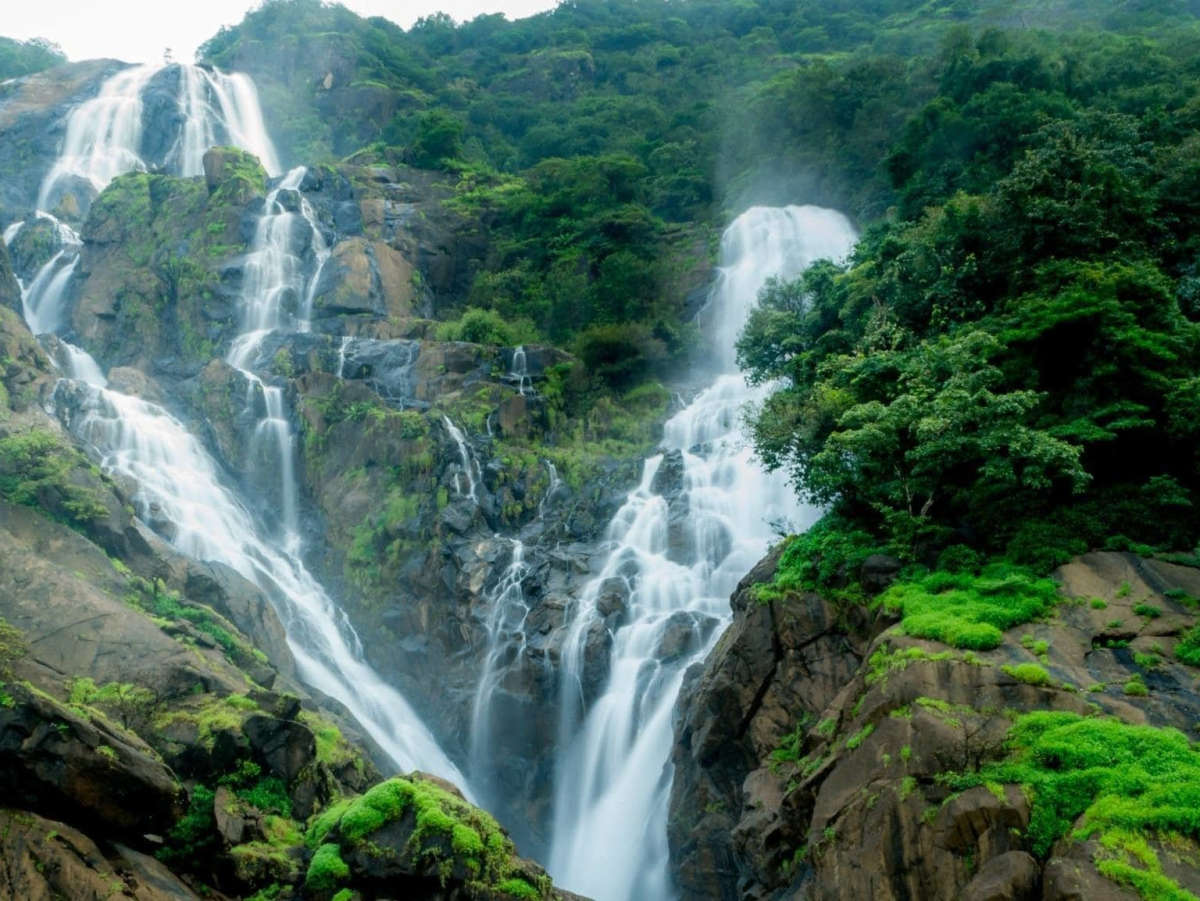The Roar and the Mist: Dudhsagar Trekking Adventure Unleashed


Introduction
Deep within the Western Ghats of India, a curtain of white water crashes from towering heights, sending mist swirling through the emerald forests. This is Dudhsagar Falls — aptly named “Sea of Milk” for its frothy torrents. But for many adventurers, the real magic lies not just in the sight of the falls but in the journey to reach them. The Dudhsagar trek weaves through lush rainforests, railway tracks steeped in colonial history, and tunnels echoing with distant train horns. It’s a symphony of sound, mist, and raw nature — an adventure that’s as thrilling as it is beautiful.
Where Exactly is Dudhsagar Falls?
Dudhsagar Falls straddles the boundary of Goa and Karnataka, tumbling from over 300 meters on the Mandovi River. The falls are part of the Bhagwan Mahavir Wildlife Sanctuary in Goa, an area renowned for its dense biodiversity. The location’s accessibility has long made it a favorite among both seasoned trekkers and first-time adventurers.
Though some visitors view the falls from nearby viewpoints or jeep safaris during peak tourist months, trekking offers a deeper connection to this magnificent landscape.
Trekking Routes: Which Path Will You Choose?
1. Castle Rock Route
One of the most popular routes begins at Castle Rock railway station in Karnataka. Spanning roughly 14 km one way, the trek winds along railway tracks, cutting through dense jungle and several dark tunnels. Each step echoes with the anticipation of discovering the roaring cascade ahead.
This trail is relatively moderate in difficulty but requires vigilance, especially in the monsoon season when tracks can be slippery. Always exercise caution around tunnels and listen for approaching trains.
2. Kulem Route
Starting from Kulem in Goa, this 11 km (approx.) route also follows railway tracks but tends to be slightly shorter and less strenuous than the Castle Rock trail. The Kulem route meanders through stunning forest landscapes and offers occasional glimpses of waterfalls and streams before culminating at the base of Dudhsagar Falls.
Some trekkers prefer this path because it’s more accessible from Goa’s tourist hubs like Madgaon and Panaji.
When is the Best Time to Trek?
Timing is everything when planning a Dudhsagar trek. The falls are most powerful during the monsoon months of June to September, transforming into a thundering torrent that sends plumes of mist skyward. However, heavy rains can make trekking hazardous due to slippery tracks, flooding, and restricted access imposed by forest authorities for safety.
For many, the sweet spot lies just after the monsoon — October to December — when the falls remain spectacular, but trails are safer and the weather more forgiving.
According to the Goa Forest Department, trekking during the dry months (January to May) is possible but less rewarding, as water volume diminishes significantly.
Things to Know Before You Go
Permissions & Entry: As per the Goa Forest Department guidelines, trekkers often need prior permission to enter forest areas, especially during the monsoon season. Check current rules to avoid fines or being turned back.
Railway Restrictions: The Indian Railways has, in the past, prohibited unauthorized walking along tracks due to safety concerns. Tour operators now offer guided treks to mitigate these risks.
Physical Fitness: While the trek isn’t extreme, it does demand moderate fitness. The walk is long, and the climate can be humid and draining.
Wildlife Encounters: The Bhagwan Mahavir Wildlife Sanctuary hosts diverse species, including monkeys, snakes, and exotic birds. Respect wildlife, and avoid feeding animals to preserve the natural balance.
Safety Precautions: Wear sturdy footwear, carry rain gear during monsoon months, and pack sufficient water and energy snacks. Mobile signals may be unreliable along certain stretches.
A Glimpse Into History
Trekking to Dudhsagar is more than a physical journey—it’s a passage through history. The railway line forming the backbone of the trek was part of the British-era infrastructure connecting Goa to the interior of Karnataka and beyond. Each tunnel and rusted milestone whispers stories of colonial engineering feats and the vibrant trading routes of old.
This blend of natural wonder and heritage lends the Dudhsagar trek a uniquely immersive allure, setting it apart from other trekking experiences in India.
Responsible Trekking Matters
Increased footfall has raised concerns about environmental degradation around Dudhsagar Falls. Trekkers are urged to follow “Leave No Trace” principles—carrying back all trash, refraining from littering, and avoiding loud noise that disrupts wildlife habitats.
The Goa Forest Department and local conservation groups emphasize sustainable tourism as the only way to preserve the region’s fragile ecosystem for future generations.
Alternatives for Non-Trekkers
Not everyone is keen on a long hike, and that’s perfectly fine. Jeep safaris to Dudhsagar Falls are available during the dry season, typically from October to May. These rides can be bumpy but allow travelers to witness the grandeur of the falls without the physical demands of trekking. However, jeeps are prohibited during the peak monsoon due to flooding risks.
Final Thoughts
The Dudhsagar trekking adventure is a perfect blend of adrenaline, natural beauty, and cultural heritage. From the thunderous roar of cascading water to the cool mist clinging to your skin, it’s an experience that lingers long after the journey ends. Whether you’re tracing railway tracks from Castle Rock or winding through the forests of Kulem, every step is a testament to the untamed beauty of India’s Western Ghats.
For those who yearn to escape the mundane and embrace the wild, Dudhsagar promises an adventure where the roar and the mist unite in a spectacle few places on Earth can match
Leave a comment